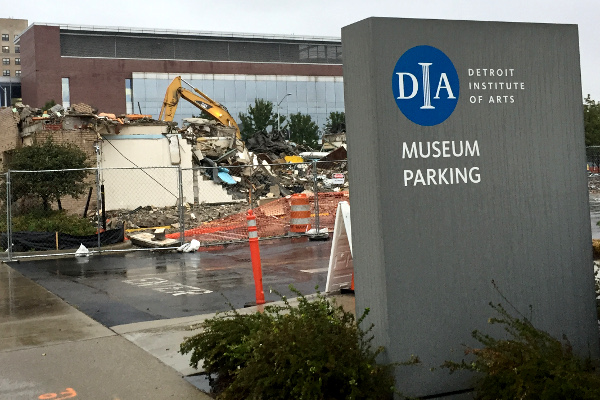
I began working at the Detroit Institute of Arts as a bookkeeper in April 2007. I had moved to the city two years before, but I was still working in Warren and excited to both live and work in Detroit. In 2011 I was promoted to Accounts Receivable Specialist. If you made a donation to the museum in the last six years, I was involved in processing that transaction in one way or another.
In October 2017, the DIA demolished the Barat House in order to expand its parking lot by 65 spaces. (I recently wrote a post about the history of the building and its architect. I recommend reading that first.) Although my job was just a minor clerical position, I have decided to leave the DIA in protest of the demolition and the manner in which the decision was made. Below are the four main reasons why I believe the DIA has made a terrible mistake.
#1. The Demolition Is Antithetical to the DIA's Mission
About a year before I started at the DIA, the following incident occurred. In February 2006, a twelve-year-old boy on a school field trip from Holly stuck a piece of chewing gum to Helen Frankenthaler's The Bay. Although the gum did not firmly adhere to the canvas, it did leave a quarter-sized stain. The painting was estimated to be worth $1.5 million.

Conservators removed the painting from the Contemporary gallery and brought it to the museum's conservation laboratory. (Conservators are the only employees allowed to touch a work of art.) Museum staff contacted the chewing gum manufacturer to inquire about the gum's chemical composition. Conservators were able to identify an appropriate solvent that would remove the stain but not damage the paint. The stain was lifted one cotton swab at a time, and eventually The Bay was restored and put back on display.
What I love about the DIA is that works of art are not simply hung on a wall. They are cherished. An uninformed cynic might dismiss an abstract painting like The Bay, but the DIA invites visitors to experience each piece in a context respectful of the artist's intentions. The museum's collection is eclectic, and each work of art is appropriately displayed and respectfully interpreted.
I can't see a distinction between art and architecture. Buildings are sculptures, and cities are museums. I do not know why one kind of art should be handled with care and respect, while another is considered disposable, good only to be torn down and sent to a landfill. Maybe Frankenthaler's The Bay isn't as popular as a Van Gogh, and maybe architect Robert Harter Snyder's Barat House wasn't as widely appealing as a Frank Lloyd Wright. But I find beauty in all of them.
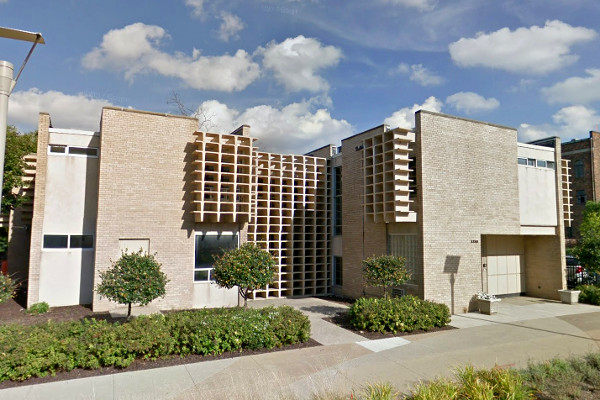
History and context can imbue a work of art with additional meaning. With The Bay, for example, I find it meaningful that Helen Frankenthaler was inspired by Jackson Pollack's innovative method of lying his canvases on the floor instead of setting it on an easel; but rather than copy his style, she developed new techniques of pouring heavily diluted paints directly onto canvas. The Bay is notable because it was the first piece in which she applied her technique using acrylic paints. With the Barat House, I find it meaningful that the building was constructed by the League of Catholic Women in order to serve some of society's most vulnerable members. I find it meaningful that the building bore the name of a Catholic saint who was an advocate of free education, regardless of gender or class. I find it meaningful that the architect taught at Cranbrook and had been a student of Eliel Saarinen. And I loved the unique, experimental nature of its facade.
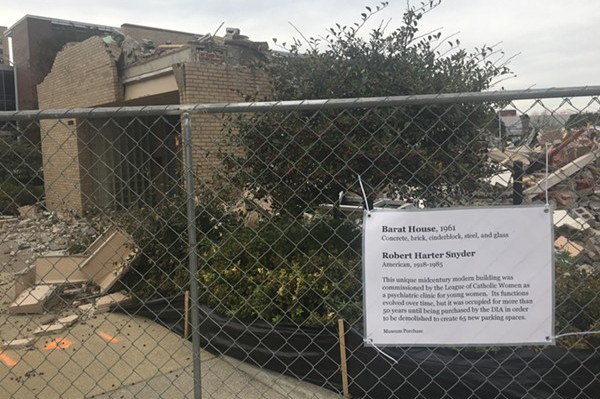
around the Barat House when demolition began.
The Barat House was part of Detroit's architectural heritage. I am disappointed that the leadership of an institution dedicated to preserving cultural artifacts went out of its way to purchase and demolish this building for a parking lot.
#2. The Demolition Erodes the City's Urban Fabric
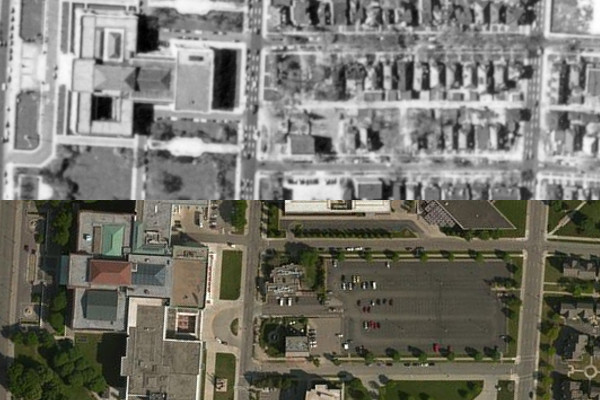
No other factor contributes more to a city's beauty, liveliness, and functionality than the physical layout of its buildings, streets, and blocks. To spend time in a well-designed public space--be it in a big city neighborhood or a small town main street--is uniquely rewarding.
What specific features do great towns and cities share? First, they require density--not necessarily to the same degree as Manhattan, obviously, but closeness between people and amenities is the reason why cities exist. An unbroken continuity of buildings encloses a street and gives it a sense of place. Healthy neighborhoods contain buildings of a variety of uses--different types of businesses with different hours attract people throughout the day. Ideally, these buildings are of a mixture of ages, and include many old ones. Great cities also tend to be "fine grained"--i.e., it's better to have a large number of small buildings than a small number of large buildings. As one DetroitYES commenter said, "It's these little buildings, not the megaprojects, that make a city."
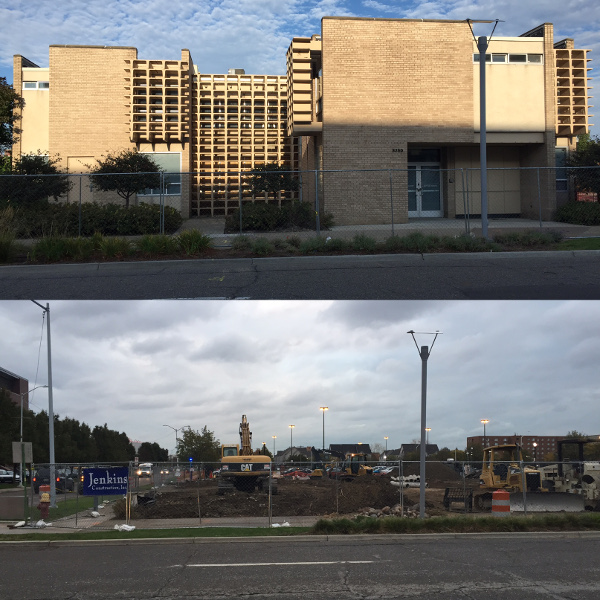
The streetscape on John R and Frederick before and after demolition.
The Barat House provided space for human activity in a city neighborhood with a growing population. It was a useful older building that allowed a nonprofit to operate in the area at a price it could afford. It sat on the Midtown Greenway Loop and provided a buffer between the DIA and its very large parking lot. Yes, it was only a single building--but with its demolition, the neighborhood is a little less dense, the local building stock is a little less diverse, and the streetscape far more barren. I believe this is a high price to pay for a handful of parking spaces.
Detroit has already lost an inconceivable amount of its urban fabric to parking lots, expressways, and suburban-style developments. It is good to accommodate visitors, but not at the expense of the neighborhood. The city just can't take any more abuse.
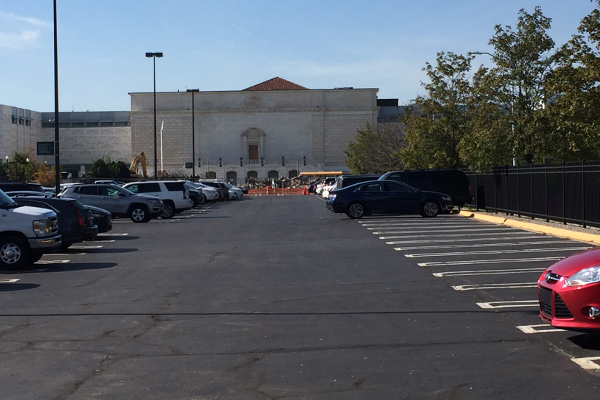
#3. This Will Not Improve Parking at the DIA
The reason why the DIA purchased and demolished the Barat House was because visitors reportedly complained about parking. Will the addition of sixty-five parking spaces satisfy them?
As urban planner Nate Hood once explained, "the perception of parking availability is different than the reality." Suburban living has primed us to expect free or cheap parking available at all times directly in front of our destinations. The briefest searches for parking and the shortest distances to walk from our cars result in disproportionate complaints. People even complain about parking in Farmington, my suburban community, although I have never had trouble parking in our downtown, ever, at all.
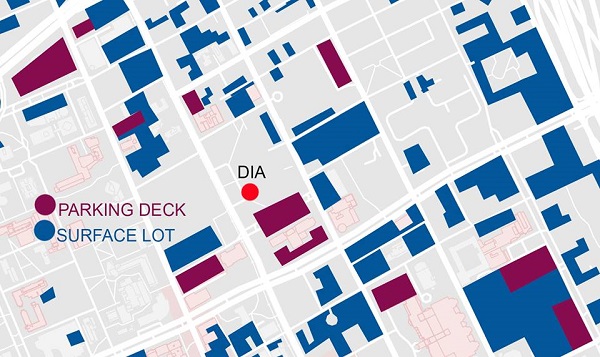
Public and private parking accommodations in the Cultural Center area.
Map by Mark Hall.
It's also important to understand induced demand, an economic principle that states that an increase in the supply of something can lead to increased demand and consumption. It's counterintuitive, but building more parking lots encourages more people to drive, which creates demand for even more parking. As urbanist blogger Angie Schmitt pointed out, there will never be "enough" parking.
A better way to improve parking at the DIA is to reduce the demand for parking. It's exciting to see new services already taking us in the right direction: the RefleX express bus service (soon to be superseded by new SMART bus routes), the QLine, and the MoGo bike sharing system can all accommodate museum visitors without requiring use of the Cultural Center Parking Lot. If autonomous vehicles become widely used, they are expected to reduce demand on parking as well.

has a station located just outside of the DIA's Farnsworth Street entrance.
Even simpler alternatives are available. The DIA could:
- Stop hosting catered events unrelated to its mission (weddings, corporate events, etc.) on weekends. (If you ever see a "Lot Full" sign outside, check inside for signs that read, "This Gallery Is Closed For A Private Event.")
- Respond to price signals and ration parking by raising prices during peak hours.
- Give employees an incentive to bike or use transit, such as reimbursing them the cost of maintaining their parking spaces if they don't use them. A California law actually requires many employers to do this. Not everyone can bike or bus to work, but many can--I rode the SMART 851 from Farmington Hills to Wayne State University on occasion, and did so every single day for the last three weeks of my job.
#4. DIA Leadership Has Acted Without Transparency
When I learned in September 2016 that the DIA had purchased and planned to demolish the Barat House, I hastily posted this information (along with some photos and a brief history of the building) on Ben Gravel's Historical Detroit Area Architecture Facebook group. As a result, I was summoned to the DIA's HR department and warned not to share "confidential" information ever again.
After that point, I anticipated some sort of announcement and public dialogue about the demolition. I prepared additional research on the building and waited, rather than initiate a discussion and risk further accusations from my employer. But by the time the demolition was formally announced, the timing could not have been worse. An internal email was sent out an hour after I left work on Thursday, September 21. The next day was my wedding day, and I was gone the rest of the following week for my honeymoon. By the time I returned to work on October 2, preparations for demolition were well underway, and workers began tearing down the facade that weekend.
There was no public announcement. There was no community dialogue. Local residents and DIA patrons were not given an opportunity to engage in a discussion about parking or the Barat House. Oddly enough, even the purchase price was omitted from the property transfer. It's not my intention to air my former employer's dirty laundry, but I do feel that the DIA leadership has become increasingly insulated, secretive, and disconnected. I believe that an institution dependent upon donors and taxpayers should operate with more transparency and less secrecy, especially given the impact the demolition will have on the public realm, and the considerable resources involved.
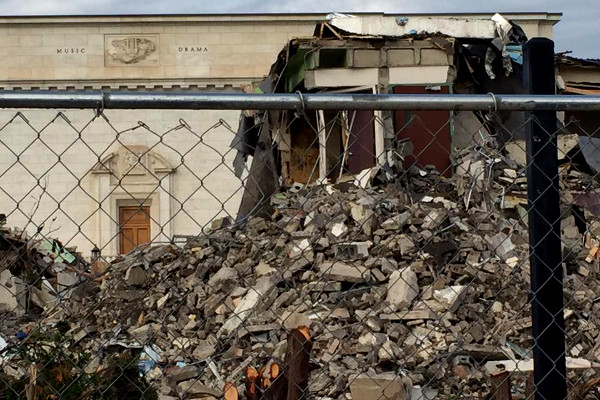
The DIA has said that other local institutions supported the conversion of the space into a parking lot, but these entities were left unnamed. There was, however, one organization mentioned by name--the museum said in a statement that it "met with the president of Preservation Detroit to let them know of our plans and gave them the opportunity to examine the building's exterior to determine if there were any materials they wanted to salvage." What the DIA left out was that Preservation Detroit emphatically opposed the demolition. "When we first learned that the DIA had purchased the building and that they were considering demolishing it, we immediately contacted their team to express our concerns," Preservation Detroit said in a statement. "Over the next year we had several meetings and conversations with DIA leadership and asked them to consider the longer-term potential of this building as opposed to the short-term gain of a handful of parking spots."
Perhaps I'm wrong on every point I've made here today. I'm not an architect or an urban planner, and no one individual has all the answers. But had there been a public dialogue, at least the facts could have been uncovered, new and better alternatives could have been suggested, and appearances of secrecy and mismanagement by the DIA could have been avoided.
Closing Thoughts
Some options for addressing parking should not be considered. For example, the DIA could fund the repair of its shuttered 368-space underground parking garage by selling millions of dollars of art--or the museum could cut down the trees on its south lawn and take a bulldozer to Tony Smith's Gracehoper to make room for a parking lot. Of course these ideas are ludicrous. Trees, art, and the Woodward Avenue streetscape all have worth beyond their monetary value. So did the Barat House. If it is unethical to sell art to make more parking spaces, then it is unethical to destroy someone else's art for the same purpose.
The DIA is not a bad institution. It's a great organization, but one that has made a bad mistake. Please do still visit and support the museum. (Remember that tri-county residents get unlimited free general admission!) And when you come to the DIA, if you have any constructive suggestions for how to improve parking (or if you would like DIA leadership to know that you have never had trouble parking nearby), please feel free to find and fill out a comment card. These are read, and they are taken seriously.
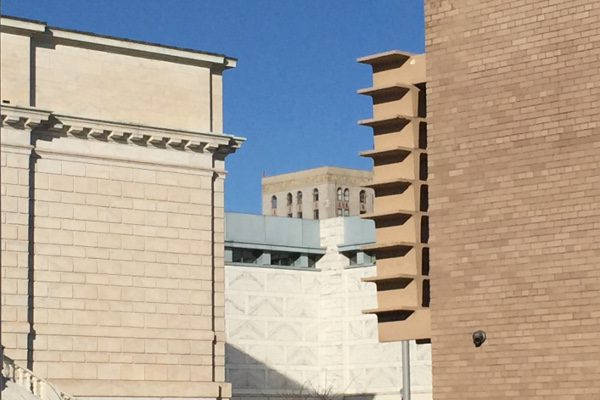
P.S. If you have any leads on jobs for a self-taught writer/researcher, yes I would like to know about them.

Thank you for sharing.
ReplyDeleteTo me, this is mostly about another surface parking lot chipping away at an otherwise thriving neighborhood (it’s amazing Midtown has been so successful despite the huge areas of institutional parking). But this site viewed in the continuum of city development, there was a building that was on this site before the Barat House and was torn down, and there will likely be a building on this site in the distant future. Proportionally, there are not enough historic districts or designations to preserve even the greatest city from individuals and institutions making poor, selfish development decisions.
ReplyDeleteConversely, apparently there are not enough institutional positions to facilitate a rich, well-reasoned, urban renewal plan that you'd advance, given your wealth of expertise and experience......smh
DeleteVery well said. Methodical. And I think you should make your next living off of "Remember the Barat House" t-shirts which you can subsequently sell from the back of a strategically placed 1978 Chevy van on Farnsworth to patrons headed for the museum. ;)
ReplyDeleteThis is really well written. I'm going to share this with my Graduate course at SCAD where we approach a lot of the topics you discuss here. If I know of any resources for you I will send them your way!
ReplyDeletemy email is amandaroach922@gmail.com
DeleteThank you! We are mourning the loss of this special building, I lived around the corner at the Park Shelton and was so upset and appalled the DIA would destroy such a precious building that could have served so many as an extension of the DIA. Detroit has a serious parking addiction, so many beautiful buildings are now parking, I remember being shocked when I first realized the view from th deck at th Park Shelton was all parking garages and surface lots. Two words...No Wonder...
ReplyDeleteRemember when the Tigers decided to leave Tiger Stadium at Michigan and Trumbull for Comerica? Poor Corktown, some opined. People who made money from parking cars in their drive ways, in their back yards, on their lawns, would lose that source of income - car parking. The poor parking lot owners would suffer because no one would come to Corktown anymore. Corktown would likely wither away like so many other neighbourhoods.
ReplyDeleteWell, what actually happened? Corktown boomed! Restaurants and Bars established shuttle services to the new ball park(s). Vacant land became valuable - not to park cars on, but to develop. Granted there are many reasons for Corktown's resurgence. But the availability of street level parking lots wasn't one of the reasons. I'm afraid that if the DIA was managing Corktown, Nemo's, the Gaelic League, Lager House, Slow's, etc, etc., would have been tearing down adjacent buildings to create surface level parking. And that would have destroyed Corktown. I'm a DIA member. I'll continue to support the DIA, but tearing down the Barat House was a big mistake.
Thank you so much for this beautifully written piece! I hope you find a job you love that pays what you are worth!
ReplyDeleteVery well written, and spot on. My wife and I, longtime DIA supporters since the 70’s and 80’s, stumbled on the demolition plans (sign posted on fence surrounding Barat House) just a few weeks before while attending a DFT screening. We we appalled, not only at how its demolition ran counter to the DIA’s mission but also with it’s short-sighted and narrow-minded pursuit of a few extra parking spaces, and the apparent, calculated secrecy surrounding the move. For this reason, combined with additional recent evidence we’ve observed in the past year or two suggesting to us that the DIA has lost focus and is becoming more interested in satisfying the lowest common denominator for greater ticket sales, we’ve decided not to renew our membership in protest.
ReplyDeleteThank you for helping people get the information they need. Great stuff as usual. Keep up the great work!!! Detroit MI
ReplyDeleteSounds interesting, thanks for sharing the useful content with us and keep sharing in future.
ReplyDeleteclipping path service
Photo Retouching
Raster To vector conversion
nice blog. your write a great content.
ReplyDeletewe are basically deal in flooring services like
Epoxy Flooring Services
Car parking flooring services
Epoxy Coating Services
heavy duty flooring services
Floor Leveling services
industrial flooring services
Epoxy Self Leveling Services
Fantastic blog. Thank you for your lovely sharing
ReplyDeleteclipping path service
Very interesting to read your blog and the unfortunate demolition by the DIA of Barat House so recently for what...65 surface car spaces! I visited Detroit and the DIA recently, and stayed at the nearby Inn on Ferry Street, a wonderful series of very fine heritage houses serving as a wonderful midtown hotel. As is often the case, it is shocking to see the amount of downtown urban space given over to surface car parking or massive parking structures, resulting in a very bleak urban landscape. If the city wants to rejuvenate itself, I wholly concur with you that its not by continuing 50s and 60s comprehensive urban renewal redevelopment models, but by building on conserving its fine built fabric and communities and adding compatible new developments. I understand this is the model of redevelopment now being followed, but old ways of redevelopment thinking obviously still happen.
ReplyDeleteI'm Абрам Александр a businessman who was able to revive his dying lumbering business through the help of a God sent lender known as Benjamin Lee the Loan Consultant of Le_Meridian Funding Service. Am resident at Yekaterinburg Екатеринбург. Well are you trying to start a business, settle your debt, expand your existing one, need money to purchase supplies. Have you been having problem trying to secure a Good Credit Facility, I want you to know that Le_Meridian Funding Service. Is the right place for you to resolve all your financial problem because am a living testimony and i can't just keep this to myself when others are looking for a way to be financially lifted.. I want you all to contact this God sent lender using the details as stated in other to be a partaker of this great opportunity Email: lfdsloans@lemeridianfds.com OR WhatsApp/Text +1-989-394-3740.
ReplyDelete